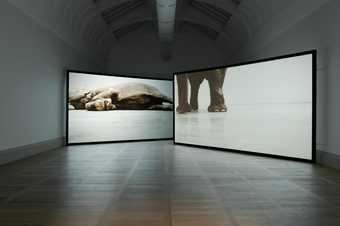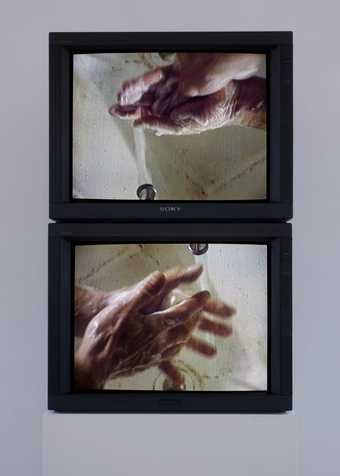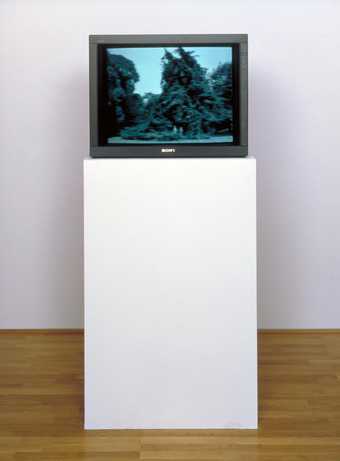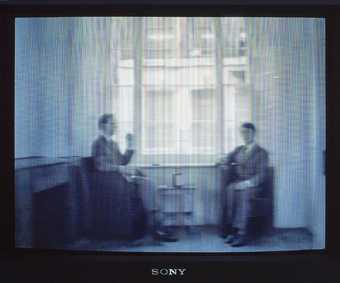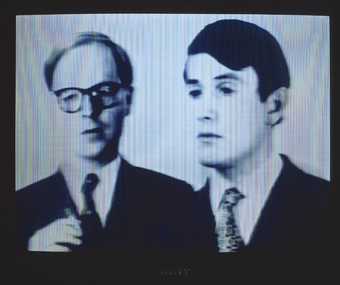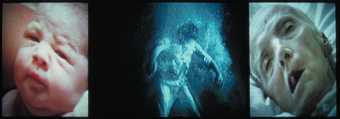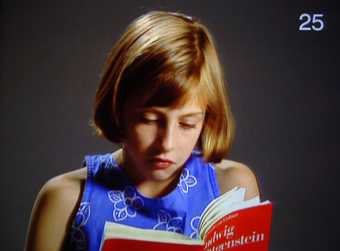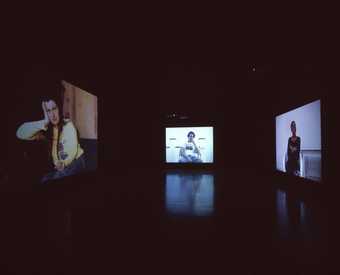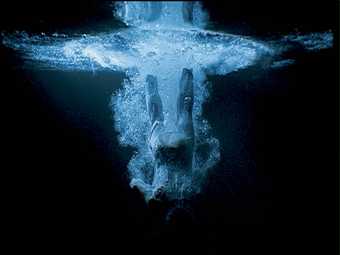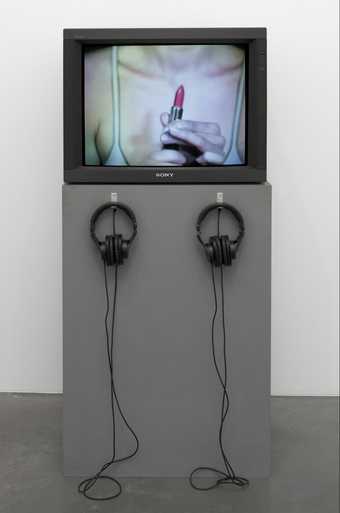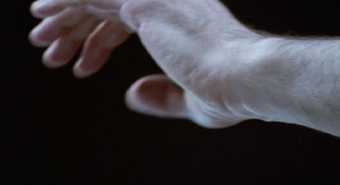
Not on display
- Artist
- Pipilotti Rist born 1962
- Medium
- Video, monitor, colour and sound
- Dimensions
- Overall display dimension variable
duration: 5 min., 2 sec. - Collection
- Tate
- Acquisition
- Presented by the Patrons of New Art through the Tate Gallery Foundation 2003
- Reference
- T07972
Summary
This five-minute single-channel video work was made while Rist was still an art student at the School of Design in Basel, Switzerland. It was produced in an unlimited edition and is intended to be shown on a domestic-style monitor, although it may also be displayed as a projection with special permission from the artist. The video depicts the artist, an attractive young woman in a low cut black dress, in an empty white space. She dances manically around the room while repeatedly singing ‘I’m not the girl who misses much’. The phrase is an adaptation of the first line of the Beatles song ‘Happiness is a Warm Gun’, 1968. The song, written by John Lennon (1940-80) about Yoko Ono (born 1933), begins ‘She’s not a girl who misses much’. Referring to her childhood Rist has said, ‘In my village in Switzerland I had a small window on the art world through the mass media; through John Lennon/Yoko Ono I moved from pop music to contemporary art. In return, I will always be grateful to popular culture’ (quoted in ‘I rist, you rist, she rists, he rists, we rist, you rist, they rist, tourist: Hans Ulrich Obrist in Conversation with Pipilotti Rist’, Pipilotti Rist, p.16). Indeed, this work can in some ways be seen as an homage to Ono, whose video and sculptural work was an early influence on Rist.
In post-production the artist manipulated the video, speeding up and slowing down certain sequences of the footage and soundtrack so that her voice alternates between a high-pitched squeal and a funereal dirge. As Rist sings her energetic dancing causes her breasts to pop out of her dress. She bends and flails her arms and lifts her skirt above her head. She approaches the camera, flashing a wide lipsticked smile. As the soundtrack slows to a low moan, she slides down the wall almost off-camera, then re-emerges as the tempo picks up to a frenetic, cartoon-like pace. The comic sonic manipulations and endless repetition of the title phrase turn the words she is singing into a meaningless mantra.
Rist also modified the colour balance so that some sequences of the video appear as if seen through a red filter while other parts are washed in blue. As the work progresses the horizontal and vertical hold are increasingly distorted, fragmenting the image. A series of juddering freeze frames creates the appearance of a fluctuating line that punctuates the surface of the screen with the rhythmic cadence of a heart monitor. Rist intends these distortions to reflect subjective experience. She has said, ‘In I’m Not the Girl Who Misses Much, the ... use of different speeds is for me an exorcistic dance. When I present things in slow motion, I would say that’s “reality”, because our perception of time is subjective. When you’re nervous, a half hour can feel like an eternity, and when you’re feeling contemplative, it goes so fast. So time is extremely relative’ (quoted in Harris).
When it was first shown I’m Not the Girl... was interpreted by critics as an ironic comment on the representations of women on the popular music video station MTV. By appropriating and wittily subverting the language of music video, Rist was seen to be making a feminist response to the often slick, sexist images on the channel. Rist has denied seeing MTV before making the work, but her use of popular music and technical fluency with the video medium suggest parallels with pioneering experiments on the station by artists including Laurie Anderson (born 1947). Rist’s work has also been influenced by visual artists who worked with video, particularly Nam June Paik (born 1932).
Further reading:
Peggy Phelan, Hans Ulrich Obrist, Elisabeth Bronfen and Pipilotti Rist, Pipilotti Rist, London, 2001, reproduced in colour, pp.13-15.
Pipilotti Rist: Himalaya, exhibition catalogue, Kunsthalle Zürich and Musée d’Art moderne de la Ville de Paris, 1999, reproduced in colour, unpaginated.
Jane Harris, ‘Psychedelic, Baby: An Interview with Pipilotti Rist’, Art Journal, vol.59, no.4, Winter 2000, www.findarticles.com/cf_dls/m0425/4_59/69294352/p1/article.jhtml.
Rachel Taylor
March 2004
Does this text contain inaccurate information or language that you feel we should improve or change? We would like to hear from you.
Display caption
Rist’s videos and installations often combine performance, dance, drawing, painting, and sculpture. The title of this work is adapted from the opening line of the Beatles song Happiness is a Warm Gun, ‘She’s not a girl who misses much’. Performing with manic energy, Rist repeatedly sings her version of the line. However, the video is deliberately subject to distortion effects and speeded-up, leaving her voice sounding as though she had just inhaled helium. Rist presents a response to the erotic metaphor of the original song, as seen through the visual language of MTV.
Gallery label, September 2004
Does this text contain inaccurate information or language that you feel we should improve or change? We would like to hear from you.
Explore
- leisure and pastimes(3,435)
-
- music and entertainment(2,331)
-
- dance(296)
- music, pop(60)
- singing(77)
- actions: expressive(2,622)
-
- gesticulating(130)
- woman(9,110)
- self-portraits(888)
- government and politics(3,355)
-
- feminism(116)
- popular culture(61)
- gender(1,689)
- arts and entertainment(7,210)
-
- artist, multi-media(393)
- student(349)
You might like
-
Douglas Gordon Play Dead; Real Time (this way, that way, the other way)
2003 -
Bruce Nauman Setting a Good Corner (Allegory and Metaphor)
1999 -
Bruce Nauman Washing Hands Normal
1996 -
Gilbert & George In the Bush
1972 -
Gilbert & George Gordon’s Makes Us Drunk
1972 -
Gilbert & George A Portrait of the Artists as Young Men
1972 -
Bill Viola Nantes Triptych
1992 -
Gary Hill Remarks on Color
1994 -
Sam Taylor-Johnson OBE Killing Time
1994 -
Bill Viola Five Angels for the Millennium
2001 -
Sanja Ivekovic Make-up - Make-down
1978 -
Rabih Mroué On Three Posters
2004 -
Omer Fast CNN Concatenated
2002 -
Andrea Fraser Museum Highlights: A Gallery Talk
1989 -
Douglas Gordon Feature Film
1999

